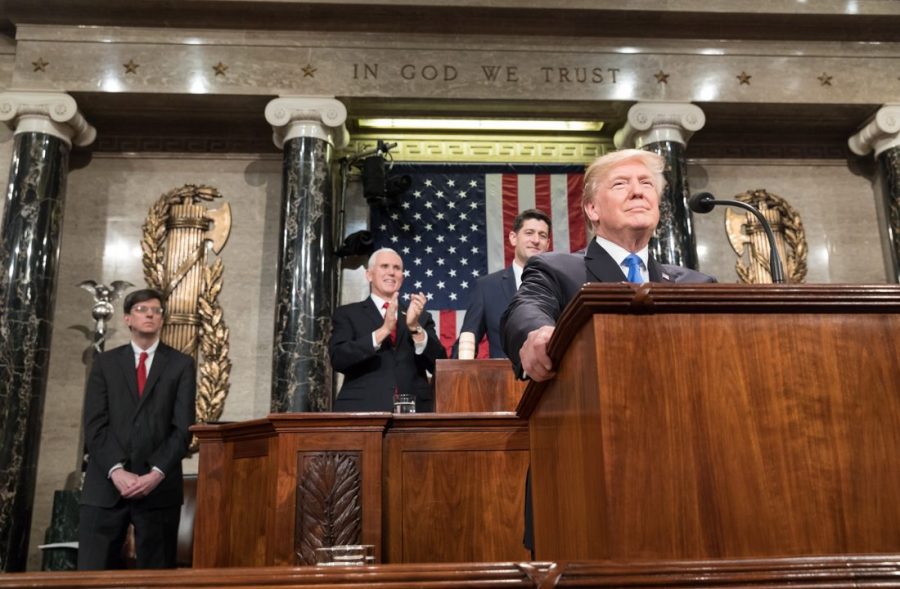To Listen or Not to Listen: Protesting at the State of the Union
Shealah Craighead via Wikimedia Commons
People had different ways of protesting Donald Trump during the State of the Union Address.
Donald Trump delivered his first official State of the Union Address on Tuesday, January 30, 2018. Amidst protests and boycotts, by representatives and the general public, Trump delivered a speech demonstrating his optimism for the future and pride for what he has already accomplished. He addressed the major policies he aims to tackle: immigration, DACA, North Korea, and the opioid crisis, just to name a few. With no surprise, protests ensued; some more effective than others.
The most visible protest came from the Democratic women of Congress. Last year at Trump’s first joint-session in Congress, female members of the Democratic party wore white. As Representative Lois Frankel tweeted, this was “to oppose Republican attempts to roll back women’s progress.” Building on this idea, and taking notes from the Golden Globes, the Democratic women of Congress wore black this year. Similar to the Hollywood stars, Representative Nydia Velazquez said she wore black “for the countless brave voices of the #MeToo movement.” Other politicians wore black to fight against Trump’s controversial record with women. Adding to the protests in relation to the #MeToo movement, Representative Jackie Speier invited Fatima Goss Graves, the president and CEO of the National Women’s Law Center which is the group that leads the Time’s Up movement.
Further protests were initiated by bringing seemingly “controversial” plus-ones. Twenty-four House Democrats brought “dreamers,” immigrants who remain in America under the DACA program. Similarly, one representative brought Amy Gottlieb, who is an immigrants’ rights leader and the wife of a detained alien.
Clearly, there was a lot of protesting at the State of the Union this year. But, what was particularly interesting were the ten representatives who did not attend. Rashad Robinson, executive director of Color of Change, released a statement saying “in this political moment, compromise is complicity and total opposition is the only moral choice to the threat that Trump poses… all elected officials have a duty to stand with their constituents who are under attack by the Trump administration and boycott the State of the Union.” A petition released by the organization gained 57,725 signatures and ten representatives made their voices heard by pledging to skip the event.
This raises the question: what is more effective? While protesting, should people rise up by showing up or should they be heard through their absence? Though they detest much of what Trump says and does, many were there to protest, whether they did so by bringing someone or wearing something symbolic. Also, in many ways, being there is much more difficult: it requires sitting and hearing every word of his speech, whether or not he or she agrees. Even if it is just a “protest listen,” it sends an amazing message: we must listen to the ideas we disagree with to break down the barriers of partisanship.
The members of Congress that showed up demonstrated a belief in the American ideals, proper leadership, and the democratic process. Not showing up can promote conversation and questioning about numerous topics; however, it is easy to reject the opinion of someone who “wouldn’t even show up” or “wasn’t even there.” The message they send to other Americans tells them to not “comply with injustice” and that “compromising is complacency,” making a strong argument that they are sending the divisive message “when we disagree, we don’t listen.”
Representatives not clapping after Trump’s sentiments and these radical plus-ones are some of the most memorable moments of the night. The impact generated by not showing up does not compare. Forty-six percent of voters voted for Donald Trump, which equates to 62,979, 879 votes, so maybe the “problem” lies in the support of such policies rather than just the man himself? Listening can create protests that more people are willing to get behind. But until people understand or listen, will these protests actually be effective?
There have been a lot of protests surrounding Donald Trump in the last year. But, there has been little change in his ideas, whether it be in policy pursuits or passage rate. What if people choose to listen and protest, rather than just protest and reject? There is value in rejecting, but at this crucial point in time and political situation, the world needs a little understanding, a pretty cool plus-one, and some black clothes.
Sources: CNN, Twitter, Vanity Fair, Vox, ABC, Newsweek
Photo Source: Shealah Craighead via Wikimedia Commons
































![Stranger Things 4: What to Expect [Warning: Contains Spoilers]](https://pcpawprint.com/wp-content/uploads/2021/11/StrangerThings4-900x473.jpeg)

























































